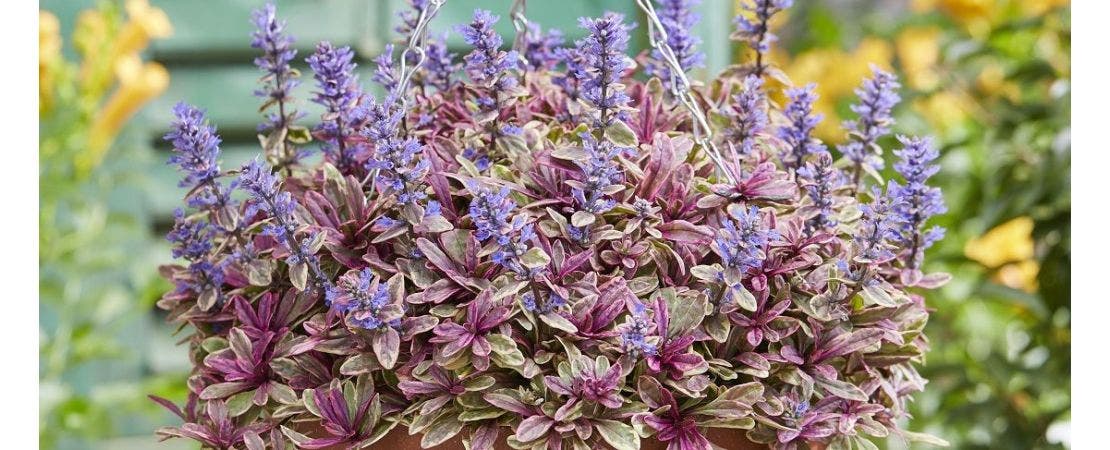You’ve Probably Seen Ajugas Without Noticing Them. They Form a Lovely Ground Cover.
Ajuga is the scientific name, but it is also the common name I use. Other common names are bugleweed, bugle, bugleherb, carpetweed, carpenter’s herb, variations on those names, and St. Lawrence plant. You do have to be mindful not to confuse ajugas with another plant called bugleweed, Lycopus species, which grows taller and used in herbal medicine.
Bugle might loosely describe the flower shape or be an old mispronunciation of ajuga. Americans add weed or herb to the name; since a bugle is a musical instrument, it feels more complete and clearer to make the longer name. European sources tend to say just bugle. Carpetweed describes its spreading, ground cover growth form. “Weed” doesn’t mean it is a problem plant; weed seems to have meant “a plant I don’t know any use for” as in joe-pye weed and fireweed when people named it. Carpenter’s herb seems to be a variation of carpetweed (or vice versa) and nobody knows why in some places ajuga is called St. Lawrence plant.
There are more than 40 Ajuga species worldwide, native to Eurasia, Africa, and Australia, but not the Americas. They are in the mint plant family, Lamiaceae, and have the square stems and flowers shaped like broad spearmint flowers that are common in that family. The ajuga most commonly grown as a cultivated plant is common bugleweed or creeping bugle, Ajuga reptans, but Italian bugle, Ajuga tenorei, and blue bugle or carpet bugle Ajuga genevensis, and hybrids, are also available. Two other species, yellow bugle or ground pine Ajuga chamaepitys, and upright or pyramid bugle, Ajuga pyramidalis appear in the USDA’s plants of the United States data base, and, being native to Eurasia, probably were cultivated years ago.
Common bugleweed, Ajuga reptans, stands out as a ground cover, explaining its popularity. It grows less than six inches high, with leaves two to six inches long. Without flowers, the plant lies practically on the ground, the leaves covering the ground all around it. The leaves are shiny and can be in colors from deep green to violet to rich reds and oranges, solid or patterned, creating a dramatic patch of ground, neatly covered in leaves.
Discover Wayside Gardens' Ajuga Collection
Ajugas spread on short rhizomes, so a plant becomes a clump, a clump becomes a bed of ajugas. They are good enough at invading that you may have to pull them out of the adjacent lawn. I find them easy to uproot but persistent—"in the rose garden again.” They are not on any U.S. noxious weed list I could find, but are included on several weed watch lists because they spread so well. Out of caution, some places will not allow them to be imported, for example, Hawaii, Puerto Rico, and Canada.
When they flower, in May and June, creeping ajugas send up a flower stalk of deep blue mint-like flowers, generally under 6” tall but capable of reaching 10” in a really good year. When an area where ajuga is the dominant plant comes into bloom, it turns the dramatic and beautiful color of the flowers, since each small plant sends up its own flower stalk. The flowers don’t have noticeable scent to humans but are attractive to flies, bees, and butterflies. If you look closely, you will see that the flowers are monoecious: some flowers on each plant have pollen on stamens, some don’t but have stigmas for receiving pollen.
As a group, the varieties of Ajuga reptans are hardy from USDA Zone 3 to 10. Different varieties are listed as, say, Zones 4-8, so pay attention to hardiness for a particular variety. They are evergreen; the leaves remain on the plant and maintain their color all winter.
The meaning of the name Ajuga is unclear. Gerard’s Herbal in 1633 listed ibigo, aiuga, and abiga as names used for the plant in Latin. You can look those up in Latin dictionaries and find a variety of possible meanings. Linnaeus in 1754 chose Ajuga for the scientific name. So, Romans called it aiuga/ajuga, but we aren’t sure why. The species epithet reptans means creeping.
Where to Plant Ajugas
Plant them as ground covers in partial shade to full sun. They will survive some foot traffic but not heavy trampling. Set them along a wall, edge, or paved area to soften the look. Try them in areas where it has been hard to establish any plants, such as on slopes. Reportedly they will grow under walnut trees, which most plants will not. They can be used as a groundcover under a line of shrubs. They spread rapidly to cover the ground and are dense enough to choke out weeds. They can be elegant in containers, for example each container with an ajuga with a different color of leaves.
More specifically, they are described as growing from full sun to full shade. The foliage color will be the best in three to four hours of sunlight. In warm climates, on a site with intense full sun, the leaves may scald. In my yard, they have nearly died out in deep shade and are expanding in relatively sunny spots. That all adds up to saying they are hardy and tolerant, but, in your yard, may do better in some spaces than others.
Put ajugas into well-drained soil, but beyond that they are not picky. They like a moderate amount of moisture but will endure dry periods. A slightly acidic soil grows them well, although they survive a wide range of soils. Ajugas favor soils with substantial organic matter but they don’t require it. Do provide good circulation in areas of high humidity. That will reduce mildew, to which they are susceptible.
They are heat- and cold-tolerant; no special protections required.
They do spread, so planting them along walks or driveways or surrounding them with an edging will keep them from invading flower beds and lawns.
How to Plant Ajugas
Simply transplant from the pot into a hole somewhat larger than the pot, wider but not deeper. Add a bit of compost or a basic fertilizer. Be gentle getting the plant out of the pot, in fact, destroy the pot if you have to, rather than hurt the plant. Loosen the roots by pulling them carefully apart at the base. This helps them spread into the soil more rapidly. Place the plant in the hole so that what was the surface of the soil in the pot is the surface of the soil in the ground. Fill in with soil, pressing down firmly. Plant ajugas 12” apart to have a series of plants, as close as 6” to have them fill in rapidly as a ground cover. Water transplants thoroughly and keep them moist for the first growing season.
You can easily divide existing plants to expand the planting. Many varieties self-seed and spread that way.
Maintaining Ajugas
Once established, they need little care. A light fertilization with a low nitrogen fertilizer in the spring, perhaps, and supplemental water in a dry period. Periodic thinning will rejuvenate a stand.
If you plant a hybrid with a dramatic leaf pattern or color, you will want to pinch off new growth that is not your chosen color. By spring, last year’s leaves are pretty battered, but the new spring leaves will spread over them, no maintenance required. Removing old flower stalks will reduce self-seeding and make the flowerbed look better sooner, but old flower stalks wither, drop off, and vanish in a month or so if you don’t remember to cut them off.
Pests and Diseases
Ajugas are deer resistant. They are technically edible to humans (new shoots, young leaves) but too bitter to be pleasant. This same bitterness discourages rabbits.
Generally, ajugas have little trouble with insects since they left most of their pests behind in Eurasia. Aphids are the most common problem and can be washed off with a garden hose.
Ajugas are susceptible to mildew, so are more satisfactory in drier locations. To reduce the chance of mildew, plant them in areas with good air circulation and avoid over-watering them.
Blue Bugle and Italian Bugle
Italian bugle (Ajuga tenorei) and blue bugle (Ajuga genevensis) are also attractive garden plants. They too spread and will beautifully fill an area. They are just a little taller than creeping bugle, blue bugle to 12” high, for example, so are not as easily used as ground covers. Plant them along a wall or in a dramatic stand. Both Italian bugle and blue bugle hybridize easily with creeping bugle so nurseries have created many low-growing hybrids, making an even broader array of colors and textures available from ajugas.
The scientific name for Italian bugle is variously given Ajuga tenori, A. tenorii, and A. tenorei online. Only Ajuga tenorei appears in lists of accepted species names. It is from the mountains of Italy and is rare in the wild. Apparently, it was named after its discoverer, the Italian botanist Michele Tenore, (1780-1861), making Ajuga tenorei the right spelling, since that says “Tenore’s ajuga” in Latin.
Blue bugle is the Geneva ajuga, the species epithet genevensis means “of Geneva, Switzerland.”
Cover problem areas with ajugas for a low-maintenance splash of bright color.








